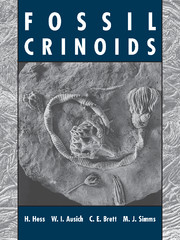Book contents
- Frontmatter
- Contents
- List of Contributors
- Acknowledgements
- Prelude
- Introduction
- GENERAL PART
- 1 Crinoid Form and Function
- 2 Systematics, Phylogeny and Evolutionary History
- 3 Fossil Occurrence
- 4 Taphonomy
- 5 Ecology and Ecological Interactions
- ASSEMBLAGES
- Appendix I Geological Time Table with Crinoid Assemblages
- Appendix II Glossary of Rocks
- Bibliography
- General Index
- Taxonomic Index
1 - Crinoid Form and Function
Published online by Cambridge University Press: 10 November 2010
- Frontmatter
- Contents
- List of Contributors
- Acknowledgements
- Prelude
- Introduction
- GENERAL PART
- 1 Crinoid Form and Function
- 2 Systematics, Phylogeny and Evolutionary History
- 3 Fossil Occurrence
- 4 Taphonomy
- 5 Ecology and Ecological Interactions
- ASSEMBLAGES
- Appendix I Geological Time Table with Crinoid Assemblages
- Appendix II Glossary of Rocks
- Bibliography
- General Index
- Taxonomic Index
Summary
ANCESTORS, ARCHITECTURE AND ADAPTATION
Environmental adaptation accounts for much of the morphological variety within the class Crinoidea, but two other factors also have an important influence on gross morphology. First, crinoid morphology is constrained by the evolutionary history of the group; in other words, much of a crinoid's morphology is inherited from its ancestors. This is particularly evident in the pentaradiate symmetry and calcite endoskeleton that dominate echinoderm morphology. Second, the crinoid skeleton and soft tissues have certain physical properties and limits within which the animal must operate. Some aspects of crinoid morphology are strategies for reducing these architectural constraints rather than being direct adaptations to particular environmental factors. For example, the crinoid skeleton is composed largely of discrete ossicles connected by ligaments and other soft tissue. By adopting this multi-element construction, crinoids overcome the inherent inflexibility of individual calcite ossicles.
To understand the functional morphology of crinoids, fundamental constraints of ancestry, constructional materials and ecology must be considered. Crinoids are the most primitive group among extant echinoderms and, typically, retain at least a vestige of the stem that characterizes the largely extinct pelmatozoans. Like all pelmatozoans, crinoids are largely sessile and exclusively suspension-feeding.
SOFT AND HARD PARTS
The numerous calcareous plates of living crinoids are produced within the body wall, so that they are actually part of an endoskeleton. The bulk of the animal is the skeleton, with only a small percentage of living tissue. Under high magnification, crinoid plates are seen to be highly porous (Fig. 4). In life these pores were filled with tissue. This skeletal microstructure is called stereom, and it is easily recognized in well-preserved fossil ossicles and in thin sections.
Information
- Type
- Chapter
- Information
- Fossil Crinoids , pp. 3 - 30Publisher: Cambridge University PressPrint publication year: 1999
Accessibility standard: Unknown
Why this information is here
This section outlines the accessibility features of this content - including support for screen readers, full keyboard navigation and high-contrast display options. This may not be relevant for you.Accessibility Information
- 48
- Cited by
